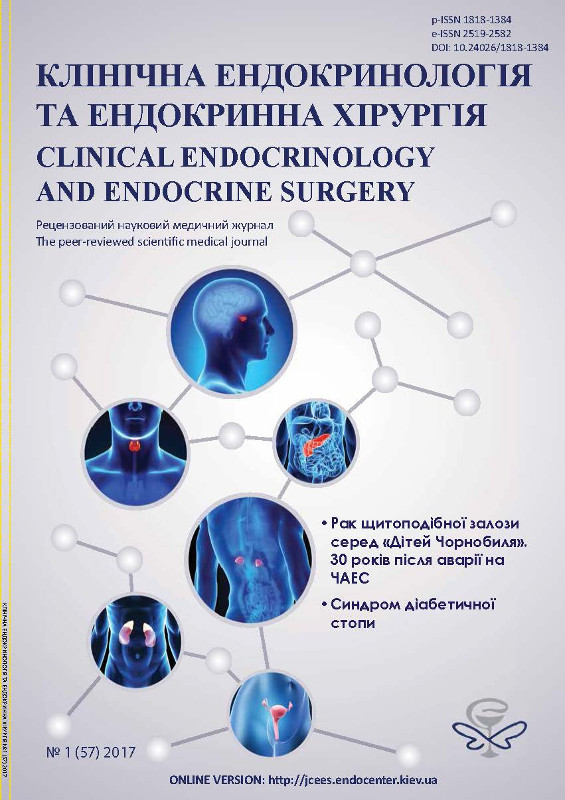Вплив цукрового діабету 2 типу на ризик переломів у жінок різного віку в постменопаузному періоді
DOI:
https://doi.org/10.24026/1818-1384.1(57).2017.97007Ключові слова:
постменопауза, цукровий діабет 2 тип, FRAX-індексАнотація
Мета дослідження – оцінка впливу цукрового діабету (ЦД) 2 типу на ризик переломів у жінок різного віку в постменопаузному періоді в залежності від стажу діабету та виду цукрознижувальної терапії. Матеріали та методи. Мінеральну щільність кісткової тканини (МЩКТ) було досліджено у 38 постменопаузних пацієнток із ЦД 2 типу (середній вік 64,36±1,95 року, середня тривалість діабету 10,68±1,88 року, середній рівень глікованого гемоглобіну 9,02±0,29 %). У групі контролю обстежено 27 практично здорових постменопаузних жінок (середній вік склав 59,62±2,59 року). Для оцінки 10-річного ризику переломів розраховували FRAX-індекс. Результати та обговорення. Результати роботи показали, що ЦД 2 типу у постменопаузних жінок нівелює вікові зміни індексу FRAX і, відповідно, ризику переломів. Тому у постменопаузних жінок хворих на ЦД 2 типу ризик переломів залишається однаково високим в обох вікових групах. Це свідчить про те, що жінки у постменопаузному періоді у віці до 60 років, які хворіють на ЦД 2 типу, знаходяться у групі підвищеного ризику виникнення переломів як променевої, плечової кістки, клінічно значущих переломів тіл хребців, стегнової кістки, так і шийки стегнової кістки. Дослідження 10-річної оцінки ризику переломів за індексом FRAX в залежності від стажу ЦД 2 типу показало вірогідне збільшення ризику перелому шийки стегнової кістки при стажі діабету більше 10 років у порівнянні із контролем (1,07±0,2% vs 0,58±0,11%, P <0,05), а міжгрупові стажеві відмінності стастично не значущі. Висновки. Цукровий діабет 2 типу у постменопаузних жінок нівелює вікові зміни ризику переломів. Показано збільшення 10-річного ризику переломів шийки стегнової кістки при тривалості діабету більше 10 років.Посилання
Kirilyuk M, Shchekaturova L, Tretyak E. [Diagnostic algorithm of osteoporosis at menopausal female with type 2 diabetes and assessment of fracture risk forecast]. Clinical Endocrynology Endocryne Surgery. 2014;2:35-38. Ukrainian.
Kovalenko VN, Povoroznyuk VV, Bortkevych OP, et al. [Guidance for diagnostic, prevention and management of osteoporosis in postmenopausal women]. Ukrainian Journal of Rheumatology. 2009;3:23-39. Ukrainian. 3. Musiyenko AS. [Mineral density of bone tissue and FRAX index in postmenopausal women]. Bol. Sustavy. Pozvonochnik. 2012;1:109-110. Russian.
Musiyenko AS. [Mineral density of bone tissue and FRAX index in postmenopausal women]. Bol. Sustavy. Pozvonochnik. 2012;1:109-110. Russian.
Povoroznyuk VV, Dzerovich NI, Karasevska TA, [Mineral density of bone tissue in Ukrainian women of different age]. Problemy Osteologii. 2006;9:3-8. Ukrainian.
Polyakov IV, Sokolova NS. Prakticheskoye posobiye po meditsinskoy statistike [Practice guidance in medical statistics]. Leningrad: Meditsina; 1975.125 p.
Anaforoglu I, Nar-Demirer A, Bascil-Tutuncu N, Ertorer ME. Prevalence of osteoporosis and factors affecting bone mineral density among postmenopausal Turkish women with type 2 diabetes. J Diabetes Complicat. 2009;23(1):12-17. https://doi.org/10.1016/j.jdiacomp.2007.06.004
Dede AD, Tournis S, Dontas I, Trovas G. Type 2 diabetes mellitus and fracture risk. Metabolism. 2014;63(12):1480-1490. Epub 2014 Sep 28. https://doi.org/10.1016/j.metabol.2014.09.002
Hadji P, Klein S, Gothe H, et al. The epidemiology of osteoporosis-Bone Evaluation Study (BEST): an analysis of routine health insurance data. Dtsch Arztebl Int. 2013 Jan;110(4):52-57. https://doi.org/10.3238/arztebl.2013.0052
Gilbert MP, Pratley RE. The impact of diabetes and diabetes medications on bone health. Endocr Rev. 2015 Apr;36(2):194-213. doi: 10.1210/er.2012-1042. Epub 2015 Mar 4. https://doi.org/10.1210/er.2012-1042
Gorman E, Chudyk AM, Madden KM, Ashe MC. Bone Health and Type 2 Diabetes Mellitus: A Systematic Review. Physiother Can. 2011 Winter;63(1):8-20. https://doi.org/10.3138/ptc.2010-23bh
Janghorbani M, Van Dam RM, Willett WC, Hu FB. Systematic review of type 1 and type 2 diabetes mellitus and risk of fracture. Am J Epidemiol. 2007 Sep 1;166(5):495-505. Epub 2007 Jun 16. https://doi.org/10.1093/aje/kwm106
Jarvinen TL, Sievanen H, Khan KM, Heinonen A, Kannus P. Shifting the focus in fracture prevention from osteoporosis to falls. Brit Med J. 2008;336(7636):124-126. https://doi.org/10.1136/bmj.39428.470752.ad
Lipscombe LL, Jamal SA, Booth GL, Hawker GA. The risk of hip fractures in older individuals with diabetes: a population-based study. Diabetes Care. 2007;30(4):835-41. doi: 10.2337/dc06-1851. https://doi.org/10.2337/dc06-1851
Mehta S. ADA: Sulfonylureas Along with TZDs May Increase Risk for Fractures. Presented at the Diabetes American Diabetes Association’s 74th Scientific Sessions, 15 June, 2014 – 165-OR- Comparative Safety of Oral Antidiabetic Therapy on Risk of Fracture in Patients with Diabetes.
Montagnani A, Gonnelli S. Antidiabetic therapy effects on bone metabolism and fracture risk. Diabetes Obes Metab. 2013 Sep;15(9):784-791. Epub 2013 Feb 24. https://doi.org/10.1111/dom.12077
Montagnani A, Gonnelli S, Alessandri M, Nuti R. Osteoporosis and risk of fracture in patients with diabetes: an update. Aging Clin Exp Res. 2011 Apr;23(2):84-90.https://doi.org/10.1007/bf03351073
Nicodemus KK, Folsom AR; Iowa Women's Health Study. Type 1 and type 2 diabetes and incident hip fractures in postmenopausal women. Diabetes Care. 2001 Jul;24(7):1192-1197. https://doi.org/10.2337/diacare.24.7.1192
Rakic V, Davis WA, Chubb SA, et al. Bone mineral density and its determinants in diabetes: the Fremantle Diabetes Study. Diabetologia. 2006;49:863-871. doi: 10.1007/s00125-006-0154-2. https://doi.org/10.1007/s00125-006-0154-2
Register TC, Lenchik L, Hsu FC, et al. Type 2 diabetes is not independently associated with spinal trabecular volumetric bone mineral density measured by QCT in the Diabetes Heart Study. Bone. 2006;39(3):628-633. https://doi.org/10.1016/j.bone.2006.03.003
Schwartz AV, Hillier TA, Sellmeyer DE, et al. Older women with diabetes have a higher risk of falls: a prospective study. Diabetes Care. 2002;25(10):1749-1754. https://doi.org/10.2337/diacare.25.10.1749
Sosa M, Saavedra P, Jodar E, et al. Bone mineral density and risk of fractures in aging, obese post-menopausal women with type 2 diabetes. The GIUMO Study. Aging Clin Exp Res. 2009;21(1):27-32.https://doi.org/10.1007/bf03324895
Tao B, Liu JM, Zhao HY, et al. Differences between measurements of bone mineral densities by quantitative ultrasound and dual-energy X-ray absorptiometry in type 2 diabetic postmenopausal women. J Clin Endocrinol Metab. 2008;93(5):1670–1675. https://doi.org/10.1210/jc.2007-1760
Vestergaard P. Discrepancies in bone mineral density and fracture risk in patients with type 1 and type 2 diabetes – a meta-analysis. Osteoporos Int. 2007;18(4):427–44. https://doi.org/10.1007/s00198-006-0253-4
Yamamoto M, Yamaguchi T, Yamauchi M, et al. Bone mineral density is not sensitive enough to assess the risk of vertebral fractures in type 2 diabetic women. Calcif Tissue Int. 2007;80(6):353-358. https://doi.org/10.1007/s00223-007-9003-7
Yamamoto M, Yamaguchi T, Yamauchi M, Kaji H, Sugimoto T. Diabetic patients have an increased risk of vertebral fractures independent of BMD or diabetic complications. J Bone Miner Res. 2009;24(4):702-9. https://doi.org/10.1359/jbmr.081207
FRAX ® Fracture Risk Assessment Tool [Internet]. Centre for Metabolic Bone Diseases, University of Sheffield, UK. Available from: http://www.shef.ac.uk/FRAX/?lang=rs
##submission.downloads##
Опубліковано
Як цитувати
Номер
Розділ
Ліцензія

Ця робота ліцензується відповідно до Creative Commons Attribution-NonCommercial 4.0 International License.





